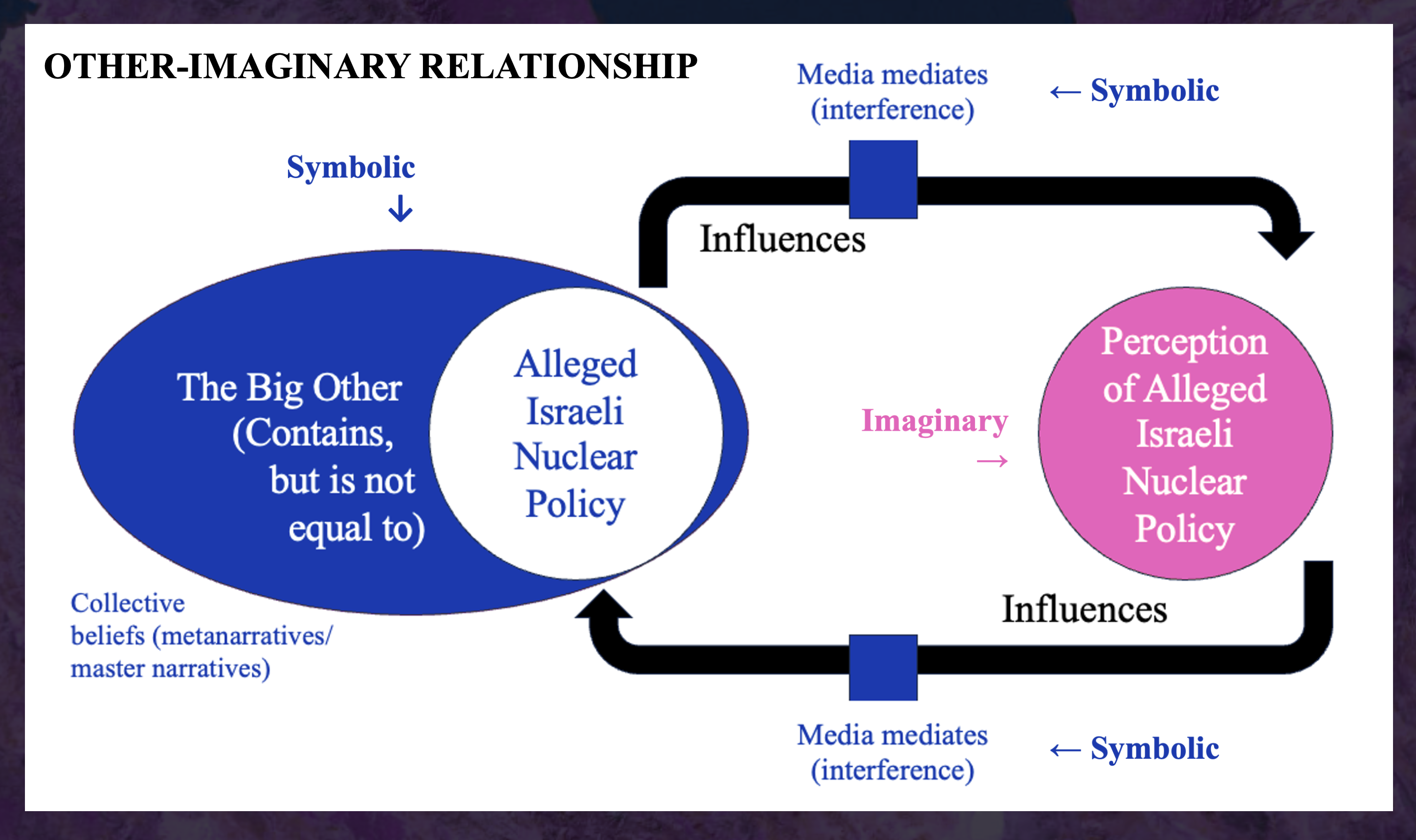Feasibility of Studying the State
of Israel’s Nuclear Ambiguity
The Lacanian “Other,” Sensationalized
Reporting, and Antisemitic Rhetoric
Sage Maysun McCarty, Chapman
University
Abstract:
The State of
Israel refuses to confirm or deny whether it possesses
nuclear weapons; this apparent policy is described as “nuclear ambiguity.” Israeli nuclear ambiguity makes it difficult
to study the state’s alleged nuclear arsenal, which the international community
tends to affirm the existence of. This
project analyzes how antisemitic bias and sensationalized reporting, as
conveyed through rhetoric, influences the feasibility of accurately studying
Israeli nuclear policy. This research
pushes innovation within media analysis by drawing the ideas of multiple
theorists—Jacques Lacan, Mark Fisher, and Slavoj Žižek—into collaboration with
each other on the subject of Israeli nuclear
policy. Specifically, this project uses
Lacan’s ideas of the Symbolic, the Imaginary, and the Real, as read through Fisher and Žižek, to develop a framework to understand
media’s role in influencing collective beliefs about Israeli nuclear
policy. This venture is largely semiotic in nature, and it is interdisciplinary
through drawing on political science, media studies, peace studies, philosophy,
and Lacanian psychoanalysis. Finally,
this project develops conclusions on how researchers can study Israeli nuclear
policy, and whether it is possible to do so, given the role of media,
sensationalized reporting, and antisemitic rhetoric in the context of this
topic.
Author’s
Bio: Sage Maysun
McCarty is a student in the University Honors Program at Chapman University. She is a senior pursuing a Bachelor of Arts
in Peace Studies and Political Science.
Furthermore, she is in her first year studying military history at the
graduate level in the MA in War, Diplomacy, and Society program as an
Integrated BA/MA student. She will
graduate from Chapman University with a B.A. in May 2026 and an M.A. in May 2027. You may contact her at samccarty@chapman.edu.
RESEARCH
QUESTION
·
How might the insights of Lacanian psychoanalysis
influence how we study Israel’s nuclear ambiguity?[i]
THESIS
·
The idea of the Other
reveals that researchers should analyze the media that policymakers use to
understand this topic.
IMPORTANCE
·
Concern for nuclear proliferation in Middle East[ii]
·
Alleged arsenal since 1960s[iii]
·
Not a signatory and/or party to main treaties on
nuclear weapons[iv]
·
October 2023: Hamas (funded by Iran) commits 10/07
terrorist attack
·
October 2023–October 2025: Israel-Hamas War
·
June 2025: USA bombs Iran
·
October 2025: Ceasefire
·
Below: Iranian nuclear facility, bombed[v]

ANTISEMITIC
RHETORIC[vi]
·
Antisemitism disguised as genuine criticism[vii]
·
Genuine criticism conflated with antisemitism[viii]
·
Conspiracy theories
·
Implying that non-Israeli Jews are more loyal to the
Israel than to their home governments[ix]
SENSATIONALIZED
REPORTING
·
Rhetoric focused on spies and secrecy

THE
REAL
·
Cannot be directly communicated
or portrayed; only filtered through symbols
·
Things that exist in physical reality[x]
·
The nuclear weapons themselves
THE
IMAGINARY
·
Collective understandings of the world; “the domain of
appearing, of how things
·
appear to us” (Žižek, Event)[xi]
·
Emerges from collective demands to know[xii]
·
Collective understandings of Israeli nuclear policy
THE
SYMBOLIC ORDER / THE OTHER
·
Also called the big Other[1]
·
Contains all symbols (words and phrases)[xiii]
·
Cannot interact with the Other, but can only interact
with those representing it[xiv]
·
Enables symbols to have meanings and attachments to
metanarratives[xv]
·
Invoking the name of “the Mossad” invokes metanarratives of
secrecy

UNDERSTANDING
THE OTHER-IMAGINARY RELATIONSHIP
·
Cybernetic process: Every output is an input[xvi]
·
Cyclical process: Collective imaginations inform the
metanarratives attached to the symbols we use, and the use of these symbols
(laden with metanarratives) influences our collective imaginations[xvii]
·
Graph is a new contribution to Lacanian
psychoanalysis and media studies
APPLICATION
·
Can only understand Israeli nuclear policy through the
Other, which shapes beliefs in the Imaginary yet is directly
unreachable
·
Researchers can only interact with representatives of the
Other: Journalists, activists, PR officials—including Israeli political
officials acting in a PR capacity[xviii]
·
Information is
twice-mediated/twice-mediatized/twice-distorted (first via officials, then via
journalists) by the time it reaches researchers[xix]
·
Each distortion adds connotations to information
(conveyed through symbols)[xx]
·
Distortions can cause sensationalized and antisemitic
ideas to enter the Imaginary, especially when they are
regurgitated by researchers
CONCLUSION:
CAN WE STUDY ISRAELI NUCLEAR POLICY?
·
Yes; focus on rhetoric and how it
justifies military and political power[xxi]
·
To understand how to disrupt the cycle, use dynamical
systems theory[xxii]
·
Focus on what media non-Israeli policymakers use to
understand the topic
For references, please visit
smm-academic.neocities.org